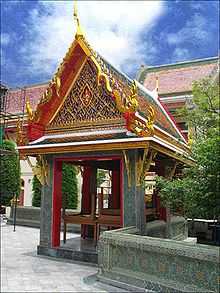Sala (architecture)

A Sala (Thai: ศาลา Thai pronunciation: [sǎːlaː]; Khmer: សាលា Khmer pronunciation: [saːliːə]), also known as a sala Thai, is an open pavilion, used as a meeting place and to protect people from sun and rain. Most are open on all four sides. They are found throughout Thailand in Buddhist temple areas, or Wats, although they can also be located in other places. A person who builds a sala at a temple or in a public place gains religious merit. A sala located in a temple is called a salawat (ศาลาวัด). Some temples have large salas where laity can hear sermons or receive religious instructions. These are called sala kan parian (ศาลาการเปรียญ), meaning pavilion where monks learn for the Parian examination. The city halls or offices of the province governors are called sala wa kan (ศาลาว่าการ, literally meaning a government pavilion) or sala klang changwat (ศาลากลางจังหวัด, literally meaning a provincial main pavilion).
In Thailand, they have many purposes similar to the roadside pavilions of Asoka. In rural areas, travelers can use them to rest and reflect. These salas are called sala asai. One at the roadside is a sala rim thanon (ศาลาริ่มถนน) and may be used as a bus stop. If on a riverbank or canal at a landing-place for watercraft, they are called sala tha nam (ศาลาท่าน้ำ “water pier pavilions”).
Etymology
Sala is most likely of Indic language origin. It can either come from Sanskrit शाला (IAST: śālā), cognate of Hindi शाल, meaning hall, large room or shed.[1] Another view is that the word comes from a root meaning thatch, thatched roof, lean-to or shed.[2] It forms part of the name of Makkhali Gosala, an ascetic teacher of ancient India said to have been born in a cowshed.
See also
References
| Wikimedia Commons has media related to Sala (architecture). |
- ↑ "sala". Spoken Sanskrit Dictionary. Retrieved 2012-06-11.
- ↑ Turner, Sir Ralph Lilley (1985). "cāla 4770". A Comparative Dictionary of the Indo-Aryan Languages. London: Oxford University Press, 1962-1966. Includes three supplements, published 1969-1985. Digital South Asia Library, a project of the Center for Research Libraries and the University of Chicago. p. 278. Retrieved 21 Aug 2010.
cāla 4770 cāla3 masculine ʻ thatch ʼ attested only in lexicographical works; Assamese sāl ʻ roof of a house ʼ; Bengali cāl ʻ thatch of a house ʼ; Oṛiyā cāḷa, °ḷā ʻ sloping thatch of a house ʼ, cāḷi ʻ a thatched lean-to shed ʼ; Maithilī cār ʻ thatched roof ʼ; Hindī cāl m. ʻ thatch or roof of a house ʼ.
- East-West Center, A Commemorative Book by the Thai Students at the East-West Center on the Occasion of the Presentation of the Asia Pacific Community Building Award and Dedication of the Royal Sala Thai, Honolulu, East-west Center, 2008.